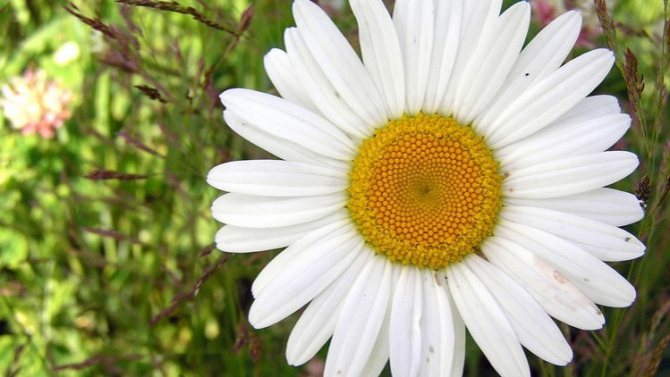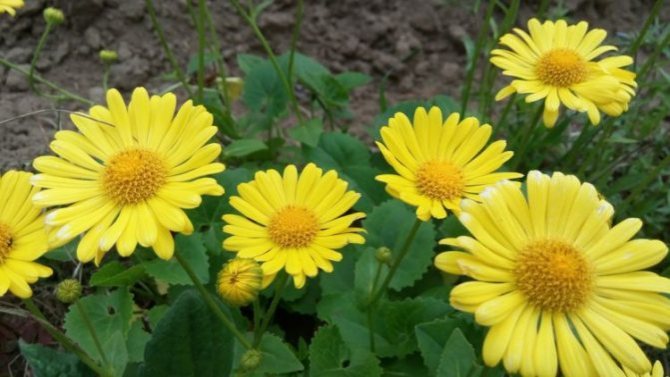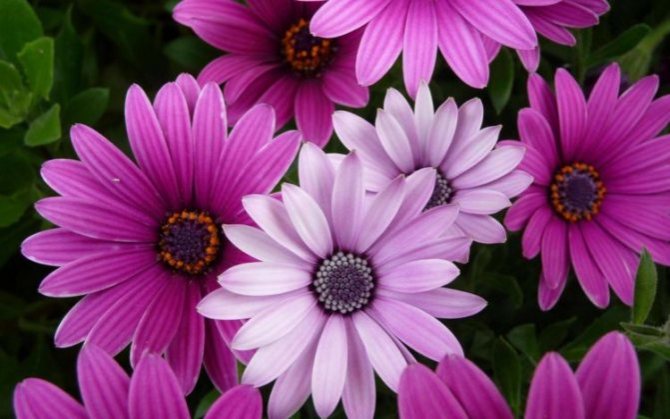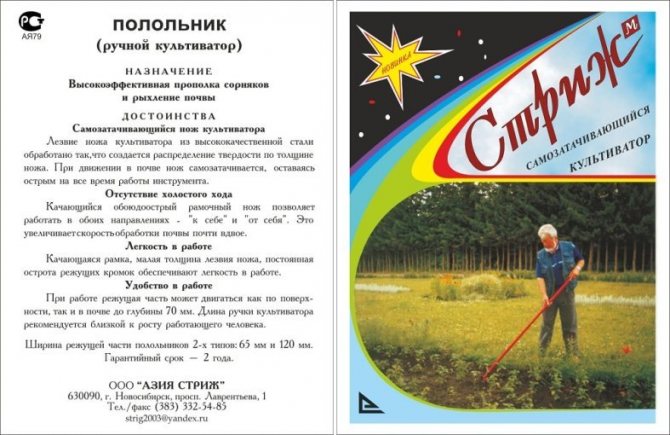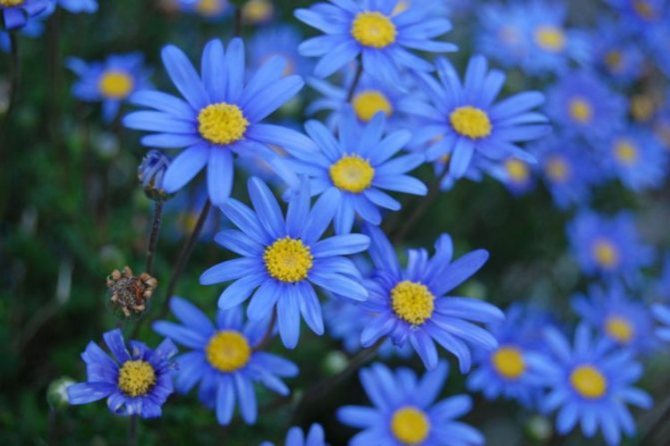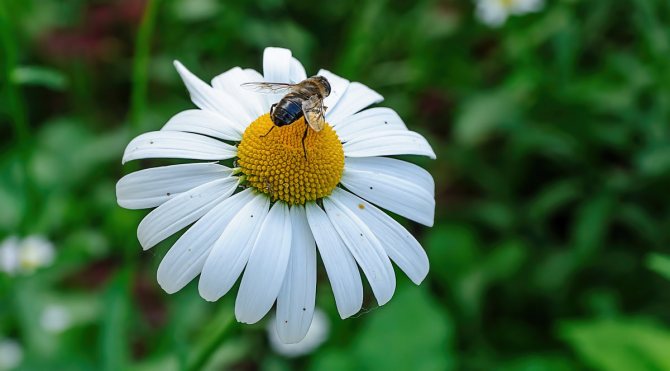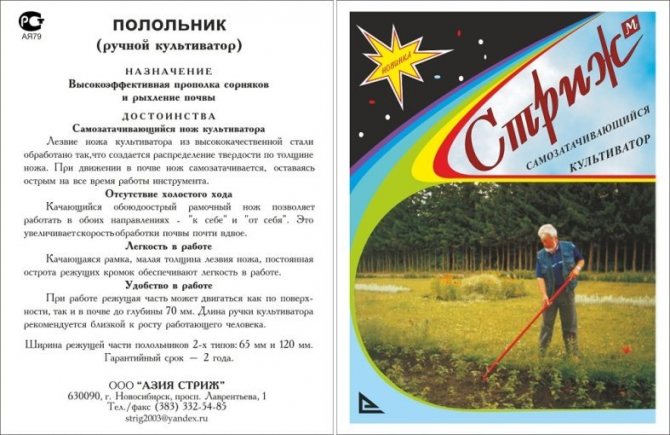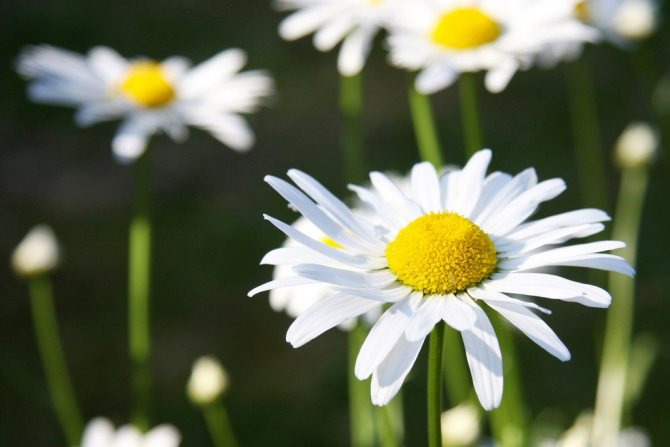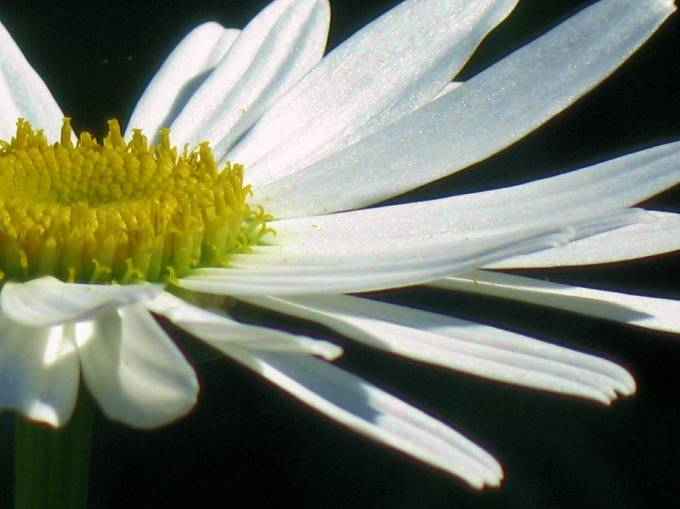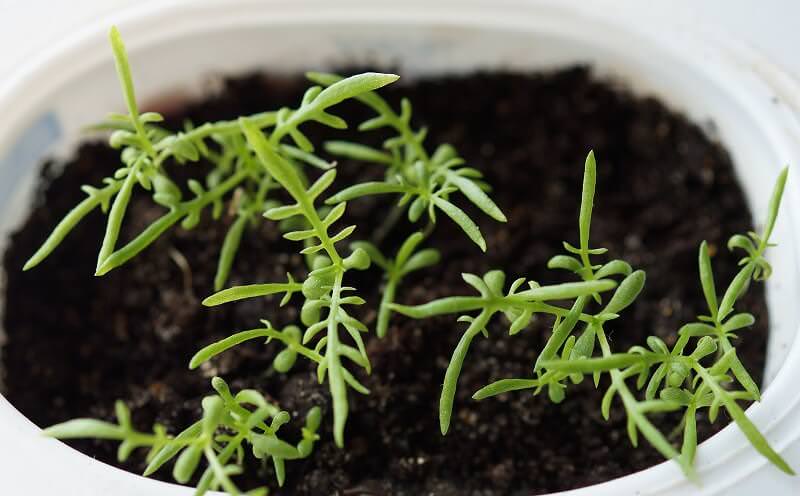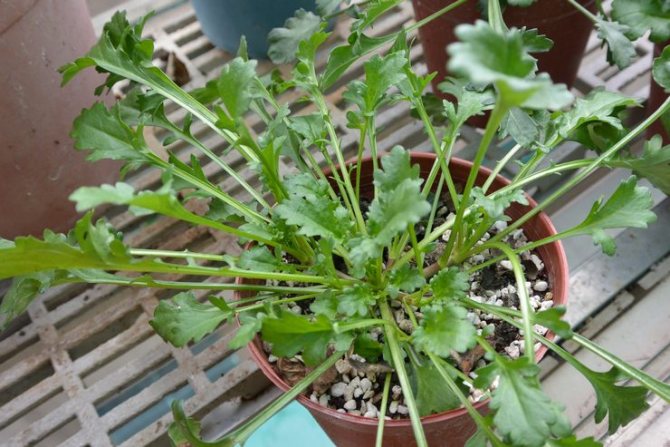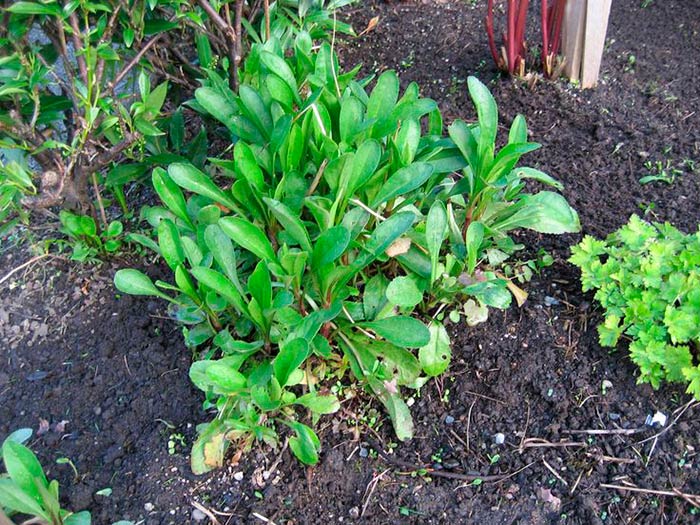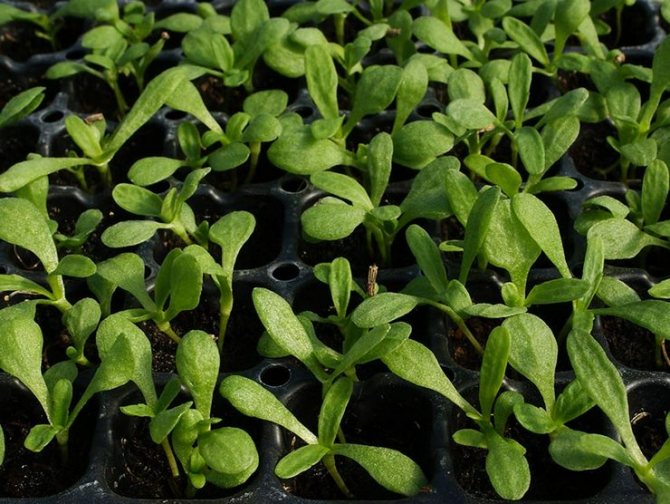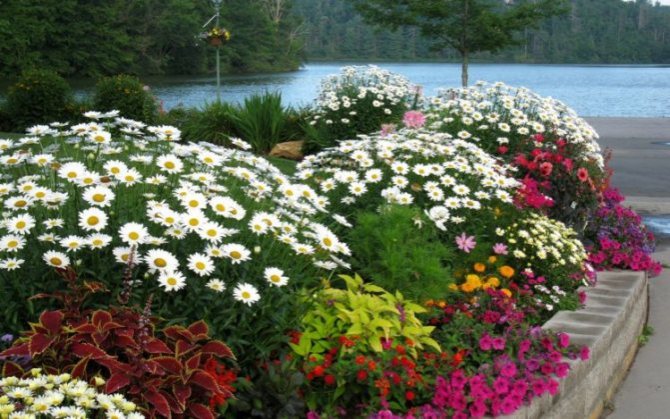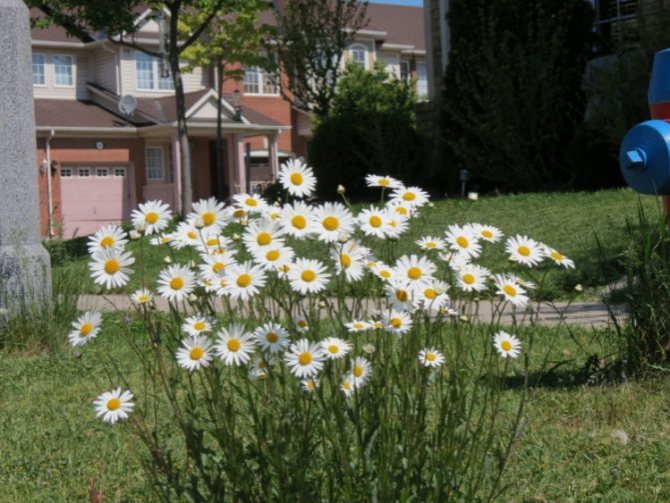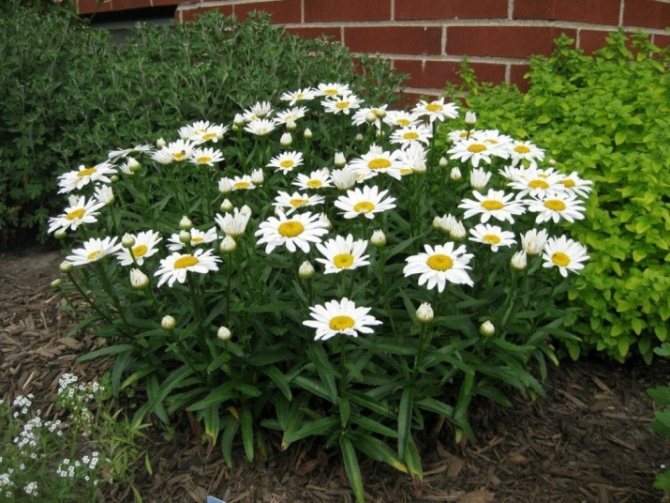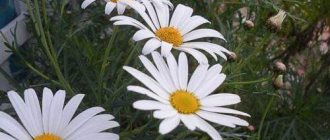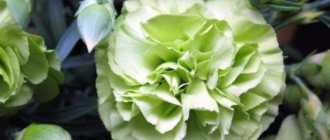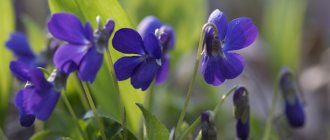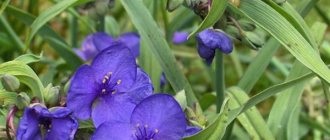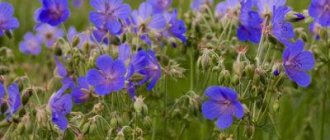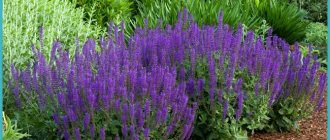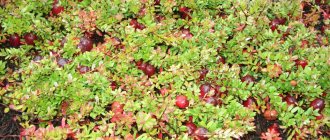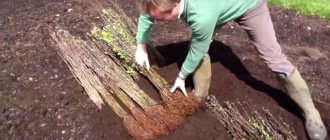Large (giant) garden chamomile Is a very beautiful flower that has been decorating the garden for many years. It is unpretentious and does not need super complicated care. However, the following guide should not be neglected, as insufficient or irregular care can lead to dire consequences.
First of all, when taking care of a large garden chamomile, you must take into account three "golden" rules:
- avoid over-watering;
- prevent the expansion of weeds;
- do not forget to regularly loosen the soil.
Nevertheless, in plant care there are a number of special cases associated with reproduction, preparation for winter "rest" and the prevention of fungal infections. What does a gardener need to know who grows or decides to grow a large garden chamomile to make the plant feel comfortable?
Morphological description
Large (giant) garden chamomile - a perennial herbaceous bush plant belonging to the Asteraceae (Compositae) family. Feature - large inflorescences, mainly with snow-white petals and a yellow heart.
Often a large garden chamomile is called a cornflower. From a botanical point of view, this name is incorrect: the daisy belongs to the same family, however, the chamomile flowers are slightly smaller, and the leaves are thinner and more delicate, not whole.
Blue, pink and red flowers that look like daisies
There are several types of plants that are very similar in type to garden chamomile, but have colored petals:
- Feverfew or in another way Persian (Dalmatian) chamomile (Pyretrum parthenium). The plant is an unpretentious perennial, growing from fifty to one hundred centimeters in height. On strong long peduncles there are flowers with a diameter of six to twelve centimeters, with a bright yellow center surrounded by red petals. Currently, many hybrid forms of the plant have been bred with simple, semi-double and double inflorescences of pink, crimson, burgundy and yellow. Blossoming of maiden feverfew occurs in June and continues throughout the summer;
- Erigeron or small petals (Erigeron). This perennial plant reaches a height of sixty to eighty centimeters. Its flowers are very similar to chamomile and are characterized by a yellow core and narrow densely spaced petals of blue, lilac, lilac, purple, red and pink colors. The diameter of the flower basket reaches five centimeters. This plant begins to bloom in early summer and continues until mid-August.
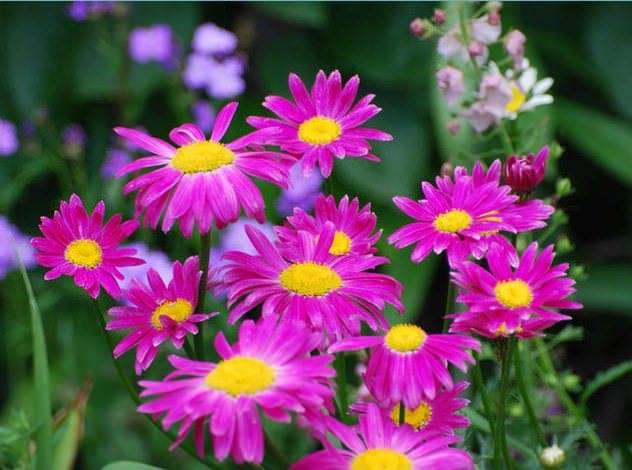
These plants can be harmoniously combined with garden daisies in a variety of garden compositions. In addition, they have similar conditions of detention and care rules.
How to grow more crops?
Any gardener and summer resident is pleased to receive a large harvest with large fruits. Unfortunately, it is far from always possible to get the desired result.
Plants often lack nutrition and minerals.
It has the following properties:
- Allows increase yield by 50%
in just a few weeks of use. - You can get a good harvest even on low fertile soils
and in adverse climatic conditions - Absolutely safe
Growing on the site
There are several ways to grow a garden chamomile. Which method to choose depends on what time of the year the planting takes place.
Seedling method of growing
- a deepening is made in the ground up to 30 cm;
- fertilizer is laid in the hole: compost or organic-mineral mixture;
- it is not necessary to remove old soil from the roots in order to avoid damage;
- the soil after planting must be irrigated.
Flowering should come as early as next year, but much depends on the characteristics of the variety.
Dividing the bush
It is better to plant by dividing the bush in the first half of autumn every 2-3 years. Planting a flower is necessary for a more spectacular flowering, which fades away as the bush grows.
- the rhizome is divided into parts with several points of growth;
- the planting site should slightly exceed the rhizome of the planted plant in size;
- it is advisable to pre-fertilize the hole, straighten the root;
- after planting, the soil is compacted and watered.
Flowering begins next year.
Growing from seeds
Tips for growing large chamomile seeds:
- To collect the seeds, it is necessary to wait for the ripening of the peduncles (the petals should dry out, and the baskets should turn brown).
- Cut off and dry the inflorescences.
- Dry the seeds and remove the litter from them.
- It is recommended to store seeds in a paper bag with an air hole.
The sowing period is autumn and spring.
Chamomile is sown as follows:
- seeds are sown to a depth of no more than 2 cm;
- distance between rows - 20 cm;
- beds are recommended to mulch.
It is not recommended to make a flower garden in a shady place. Spring sowing by fall will produce seedlings that can be replanted.
Popular types and varieties of large garden chamomile.
Nivyanik
A giant of its kind the stem reaches 90 cm in height, and the diameter of the opened bud is more than 15 cm. It is frost-resistant, easily tolerates drought. But for the most effective flowering, regular watering is required.
In addition to its aesthetic qualities, the daisy is known for its healing qualities. Most often used for cutting. This variety belongs to Terry chamomile - a perennial plant, characterized by an abundance of petals filling the core. The largest variety - Nivyanik - terry chamomile is practically not inferior, reaching 70 cm in height.
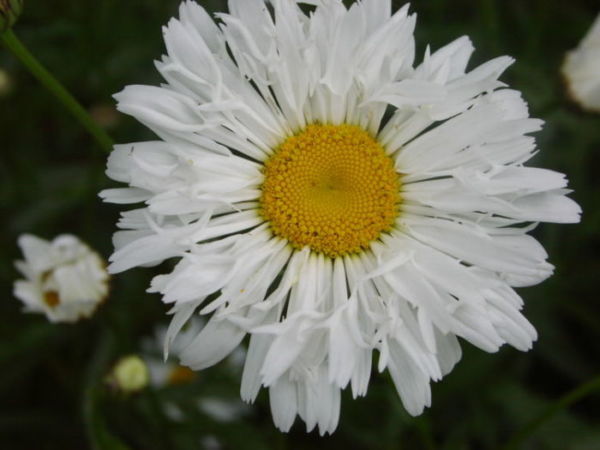

North Star
A favorite of gardeners, it is resistant to drought, size (stem length - 60-70 cm) and shining whiteness of the inflorescences. It is not recommended to plant seedlings in shady corners of the garden. Planting seedlings is possible in spring or autumn, however, flowering occurs only in the second year.
Princess
Sun-loving perennial with lush white inflorescences. It reaches a height of no more than 35 cm with a bud opening up to 10 cm in diameter. Unlike the North Star, the Princess prefers moist soil. The flowering period is the longest: from July to mid-October.


Alaska
Large-flowered plant, reaching 90 cm in height. The diameter of the inflorescence is up to 12 cm. It is planted, as a rule, in the fall and the next summer pleases with flowering. The variety is unpretentious, tolerates droughts and, like its “botanical brethren”, loves sunlight.
Colored varieties
Thanks to the experiments of breeders, there are more than 100 different colored species, among which the most popular are:
- Pyrethrum pink or Persian chamomile has a lot of varieties that differ in the saturation of the color of the petals. Often grown for cut, blending in a bouquet with other field plants. For Persian chamomile, both lack and excess of moisture are destructive. Feels comfortable in the shade. The flowering period lasts all summer.
- Red pyrethrum similar to pink, which often leads to confusion. Feature - large bright red inflorescences, which is why it is sometimes called meat-red pyrethrum.
- Yellow doronicum Is a perennial variety with bright yellow petals.Flowering occurs early - in the second half of March. During this period, the plant reaches 70 cm in height. Doronicum yellow multiplies rapidly without requiring specific care. Firmly endures frost. Unpretentious to lighting, blooms longer in shady corners of the garden.
- We should also mention the blue chamomile, which is distinguished by the dark blue color of the inflorescences. It is an annual plant that grows up to 60 cm in height. Best known for being used in medicine and cosmetology for the preparation of essential oils.
- Orange chamomile (or orange small petal) is a perennial herb with narrow bright orange petals. Sun-loving variety, grows quickly. It is used to decorate flower beds, less often for cutting.
Photo gallery: a variety of colors of colored chamomile
Feverfew, or colored chamomile
A special place in horticulture is occupied by various varieties of pyrethrum, which are also called garden daisies. This is Persian, or pink chamomile, Dalmatian chamomile, less often - meat-red chamomile - perennial shrubs, the height of the stems of which ranges from 30 to 100 cm.The diameter and color of inflorescences in different varieties can also vary greatly.
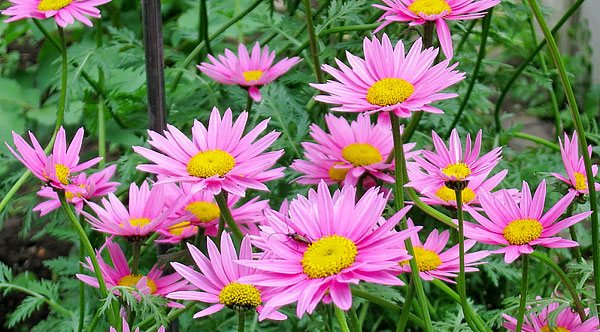

Among pyrethrum there are small-flowered species with inflorescences 2-3 cm in diameter. They grow in the wild and look very similar to chamomile. There are also large-flowered varieties, the diameter of the inflorescences of which is 5-8 cm.
As for the color of the inflorescences, it can be, like in daisies, white-yellow, and pink, blue, purple and deep red. Pyrethrum can also differ in the splendor of the inflorescences. There are species and varieties not only with simple inflorescences, but also with semi-double and double inflorescences, in which reed flowers are arranged in 3-5 rows.


Maiden tansy, decorative form
Feverfew, with the most chamomile-like inflorescences, blooms in May and June. With proper care and feeding, the shrub can bloom for the second time in a season in August or September. It should be borne in mind that inflorescences do not appear earlier than in the second year.
In feverfew, the maiden inflorescences are slightly smaller than that of the common, but more lush. Their petals grow in several rows. These flowers look like this:


Bright colored inflorescences are characteristic of Caucasian pyrethrum and some other species.
Grow to bloom
Planting and caring for an ornamental plant is a process of varying degrees of complexity. In order to grow a beautiful and full-fledged chamomile, the soil must be improved in autumn with lime fertilizers, and mineral fertilizers must be added to the soil before planting. If the soil is acidic, add dolomite flour or slaked soda. Before planting, you need to check if there is enough sun, if it is not a wetland; we must not forget about solikams.
If the chamomile remains from last year, you need to inspect the bushes and plant them by dividing the bush. To do this, the bush should be dug up and divided into several parts (usually 2-3, depending on the size of the bush), doing this with bare hands so as not to damage the root system, and then plant each part separately.
Caring for a plant is also to protect it from diseases that may appear on it, for example, powdery mildew, fusarium, gray rot and rust. To this end, you need to treat chamomile with fungicides.
After the gardener goes through the minor and major troubles of chamomile growth, the question of how to plant becomes simple and uncomplicated for him. After all, after planting, chamomile must sometimes be watered, loosened around the bush, and covered with peat so that moisture does not escape from the soil. Planting is actually quite simple, considering what you have to go through before you can cut the beautiful large home-grown flowers.
Greetings, friends!
I really like daisies! These are my favorite flowers! Therefore, I am writing this article on how to grow daisies in the garden for you with special pleasure! Let's first talk a little more about this amazing plant ...
Everyone's favorite camomile is also called "Nivyanik". It is a perennial, abundant and long-lasting flowering plant. Chamomile blooms from late June to the last decade of August. There are also chamomile varieties that begin to bloom as early as May.
Preparing for autumn planting and choosing a location
Ideally, you need to ensure that chamomile bushes are transplanted to a new location every 3-4 years. And all because there is a compaction of the earth due to the dead roots of old bushes. At the same time, the number of bushes increases, which prevents the development of both young growth and old flowers. In this case, the chamomile begins to bloom poorly.
The plant loves sunny and not damp plantations, grows well on poor soils, but grows faster and stronger on fertile soil enriched with minerals. Excessive moisture will provoke diseases of the bush, in particular, a fungus.
Organic fertilizers must be added to the soil 3 weeks before transplanting. If you plan to create a flower plantation on the site, it is better to use humus at the rate of 1 bucket per 1 sq. m. If you plant single plants, then you can add humus to the hole, mixing well with the ground. Fertilizers should be well absorbed into the soil.
How to plant a large garden chamomile in the garden?
Soil preparation and planting site selection:
- Before planting the plant, the soil is fertilized (compost - at least 1 bucket per 1 square meter, mineral fertilizers).
- For planting a large garden planting, the choice of slightly acidic soils is preferable, otherwise dolomite flour or slaked soda is added.
- Bushes need space, since garden chamomile can grow without changing place for 3-5 years;
- The landing site must be sunny.
- In no case should you choose a wetland - this will lead to the occurrence of diseases.
When and how to plant?
- Sowing of seeds takes place at the end of May - end of July.
- To grow seedlings, seeds are sown in March in specially prepared pots with drainage (or ordinary plastic cups, but you must not forget to make a hole from the bottom).
- Planting by dividing the rhizome is carried out in September - early October.
- Seedlings are planted in May.
When is the best time to transplant garden chamomile?
It is recommended to replant in the autumn, in the first half, at the end of flowering, when there are young shoots. And transplanting is also possible at the end of spring, when there is no longer frost.
The plant takes root well, but for a more effective flowering, when transplanting, mineral fertilizers or compost are placed in the hole.
Preparing for autumn planting and choosing a location
Ideally, you need to ensure that chamomile bushes are transplanted to a new location every 3-4 years. And all because there is a compaction of the earth due to the dead roots of old bushes. At the same time, the number of bushes increases, which prevents the development of both young growth and old flowers. In this case, the chamomile begins to bloom poorly.
The plant loves sunny and not damp plantations, grows well on poor soils, but grows faster and stronger on fertile soil enriched with minerals. Excessive moisture will provoke diseases of the bush, in particular, a fungus.
Organic fertilizers must be added to the soil 3 weeks before transplanting. If you plan to create a flower plantation on the site, it is better to use humus at the rate of 1 bucket per 1 sq. m. If you plant single plants, then you can add humus to the hole, mixing well with the ground. Fertilizers should be well absorbed into the soil.
Landing as the main stage
The most important thing in the process of growing chamomile is planting. It is carried out by seeds that are germinated indoors, depending on the type of climate.The question of planting chamomile in open ground with germination efficiency - in the form of seedlings or directly by seeds into the soil - is decided taking into account the duration of the last frost and the coming warming. It is still better to plant chamomile in the form of seedlings.
In order to grow high-quality chamomile seedlings, you need to attend to the process in advance. At the end of winter, fill cups, pots or honeycomb trays with damp potting mixture, plant a couple of seeds in each well, cover with a thin layer of soil and leave in a warm, moderately lit place. The seedling soil must be permanently moist. The tray is covered with plastic wrap, which is removed immediately after the seeds have germinated, after which the tray is moved in the sun or under a fluorescent lamp.
As soon as the sprouts become 5 cm in height, the excess sprouted stems are carefully pinched off above the soil, leaving the most viable ones.
Seedlings can be planted as soon as the soil has warmed up. It is best to plant chamomile in calcareous or neutral soil. The transplant is carried out after the nutrient mixture is added to the planting holes. The seeds are planted under the same conditions. The seedling pits should be 20-30 cm deep with a distance of 20-40 cm - depending on the variety. In the open field, the fate of planting depends greatly on weather conditions. The sprouts are carefully removed from the cell or pot together with the soil, so as not to damage the root system, and are planted in a hole, in fertilizers and open ground.
When and how to transplant chamomile
Experienced flower growers recommend how and when to transplant large chamomiles.
If it is spring, then it is impossible to indicate unambiguously the timing of planting seedlings in open ground, since everything depends on the weather. Seedlings must not only be grown strong, but also protected from cold and frost. When the seedlings grow enough, 4-5 true leaves will bloom on it, then it can be planted in open ground, provided that the air temperature is set at + 15 ° C or more.
Before planting chamomile seedlings in open ground, the soil is well dug up and fertilized with special preparations for flowering garden plants. After that, the bushes must be planted in 2-3 pieces, at a distance of 30-40 cm.
Very often there is such a situation that it is necessary to quickly decide where and when it is better to plant perennial adults chamomile. This happens when a plant is forced to transplant from a flower bed near the house due to construction work or the transfer of a flower garden to another place. Due to the peculiarities of the culture, the way out of this situation is quite simple - this flower is unpretentious and hardy, painlessly takes root in another place. Careful enough so as not to damage the roots, dig up the flowering plant with a clod of earth and move it to a new place, then water it abundantly.
How to propagate garden chamomile
To propagate chamomile, they resort to simple traditional methods:
- seed (growing seedlings from seeds);
- vegetative (dividing the bush).
It is possible to sow seeds both in spring and in autumn directly into open ground, seedlings will appear, but it is safer to grow seedlings. In March, seeds are sown in a special soil mixture of peat, garden soil, sand (1: 1: 1). In order not to wash the seeds out of the soil, they are watered carefully, then, to create a greenhouse effect, the container is covered with a film and placed in a dark, warm place. In order not to overdry the soil, it is constantly sprayed with water. As soon as the first shoots appear (this usually happens after 10-12 days), the film is removed, and the boxes are transferred to a sunny place.
Chamomile can multiply by dividing the bush. Despite the ability of chamomile to grow in the same place for several years, it should be periodically (after 4-5 years) renewed. New planting material is being prepared in September.An adult bush is completely dug out of the ground, after which younger root shoots are selected from it for planting.
Caring for a large garden chamomile
Watering and feeding
The plant needs regular, but not over-watering. Do not forget to mulch or drain the soil. Fertilizers are suitable both organic and mineral.
Mandatory feeding:
- nitrophoska - 2 tbsp. l. fertilizers / 10 l of water (composition for May feeding);
- superphosphate or potassium sulfate - 1 tbsp. l / 10 l of water.
Post-flowering care and preparation for winter
After the end of flowering, the plant also requires watering and loosening of the root soil. We must not forget to destroy the weed. With the end of flowering, new leaves appear in place of dead leaves, so the plant requires regular fertilization. Good for this: fresh mullein or infusion of bird droppings.
As a rule, a large garden chamomile firmly tolerates frosts in the open field, but it is better not to risk it and cover the bed with foliage before the snow falls.
Pruning and rejuvenating the bush
To strengthen the rhizome and the formation of new shoots, it is not recommended to leave the stems on the root - they must be cut off. After the chamomile has faded, the entire aerial part of the plant is cut to 10-15 cm from the ground.
Rejuvenation of the bush is the pruning of a part of the root system, takes place 5 years after planting, then it is repeated after 3 years.
How is rejuvenation performed:
- the rhizome is divided in half, one of the parts of the root system is removed;
- in place of the removed part of the rhizome, compost and new fertile soil are laid.
With subsequent rejuvenation, the older part of the rhizome is removed.
Diseases and pests
With improper care, a large garden chamomile is susceptible to fungal infections:
- rust (the appearance of red spots on the surface of the leaves);
- gray rot (damage is possible with increased soil moisture; brown spots with a gray bloom form and grow on the stem and leaves);
- fusarium (damage to the root system; the plant quickly withers and dies);
- powdery mildew (a white bloom appears on the leaves and stem, subsequently the affected parts turn brown).
Fungicides are used to prevent infections. In case of severe damage, it is better to remove the plant.
The most dangerous pests:
- aphid: the plant deforms, withers and dies;
- star-winged front sight: appears when the flower bed is overgrown with weeds; insect larvae occupy the plant, preventing it from developing;
- wireworm: can parasitize the rhizome by eating it;
- snails and slugs also cause harmwho consider the plant appetizing.
Timely weeding and loosening of the soil, as well as preventive treatment with insecticides, will help reduce the risk of pest damage.
Diseases and pests
If a flowering crop is not properly cared for, it quickly weakens and becomes most vulnerable to various dangerous infections and pests.
Large garden chamomile can be susceptible to the following diseases:
- rust - convex bright red spots appear on the leaves;
- gray rot, powdery mildew - leaves and stems are covered with a white, dark gray bloom;
- fusarium - causes damage to the root system of the plant.
If the treatment is not started on time, the plant may simply die.
You can quickly cure the disease if you resort to the use of fungicides such as:
The most dangerous pests of chamomile are aphids, star-winged fly, wireworm, slugs.
Important! Among the pests, the wireworm causes significant damage. Gnawing at the small roots, it weakens or leads to the death of the plant. To combat it, it is better to plant chamomile on soils with a reaction of the environment close to neutral. In such soil, the pest practically does not occur.
For spraying against pests such insecticides as "Iskra", "Imidor", "Fitoverm" are used.
On a note. If a favorite flower needs to be saved urgently, plain soapy water is often used. For this, take a spoonful of liquid soap for 0.5 liters of warm water, add 1/2 cup of vegetable oil to them, then mix everything thoroughly. The finished composition is sprayed with flowers for several days.
Can a flowering plant be transplanted?
Garden chamomile takes root easily, the main thing is to dig it out with a lump of earth, digging deeper so that the roots do not touch and transfer them carefully, for example, from the lawn to the flower garden. Then water well and mulch under the bush.
For spring planting, it is better to use seeds for seedlings, and before winter sowing seeds directly into the ground.
August is the month of seed collection. This month they finally ripen and are already ready for planting before the onset of cold weather. Seeds winter safely and sprout beautifully in spring, and in the second year of life, adult plants begin to bloom.
As a rule, planted chamomile, left without care, weakens and becomes overgrown with weeds. All care consists in loosening, weeding, fertilizing, watering, and after flowering, the bush is pruned and perennials are prepared for winter.
Getting started planting a chamomile bush
On the prepared soil, it is necessary to dig holes, fill them with water. Saplings are planted at a distance of about 20 cm from each other. If you plant chamomile in rows, then there should be a distance of at least 50 cm between them. The roots of the plant should be covered with earth tightly. For the winter, planting daisies should be wrapped in straw or fallen leaves by 5 cm.


Large garden chamomile in landscape design
Large garden chamomile is famous in floristry and is used to decorate a garden plot, flower beds, where it goes well with other garden flowers. Perfectly coexists with unpretentious wildflowers, such as poppies, cornflowers, bells.
Nivyanik goes well in one composition with flowers such as lilies. In addition, the plant feels comfortable on a Moorish lawn. Low-growing varieties adorn the borders. Sometimes I grow garden chamomile in decorative flowerpots on terraces.
The success of this plant in modern landscape design lies in the duration of flowering and friendliness in relation to other garden plants with which they form group plantings.


Large chamomile in garden design
Reproduction
By dividing the bush and its roots into several parts, they not only multiply, but also rejuvenate the plant. The more often rejuvenation and transplantation occurs, the larger the flowers will be and the more magnificent their flowering. Otherwise, the plant weakens, and the number of inflorescences decreases with each season.
Work is best done at the very beginning of autumn. To do this, choose a healthy bush that has already bloomed, and divide it into 2-3 parts. After that, you need to clear the soil of weeds, dig holes for each plant. Add fertilizer - compost or mineral fertilizer to each hole. Sprinkle the plant with earth, squeeze it and water it. Chamomile will bloom next year.
It is not recommended to take seeds of faded flowers, as they do not retain the features of the parent varietal plant. If there is a desire to propagate with the material of your flowers, then you need to cut off the faded heads, dry them, peel off the seeds and put them in a paper bag. Chamomile seeds are very hardy. Therefore, it is possible to sow them after the snow melts and before frost. Autumn sowing provides friendly shoots of strong plants.
Reproduction of chamomile garden seeds is carried out either by sowing in the ground, or by seedlings. Flowers grown by seedlings are stronger, stronger, more resistant to diseases and bloom earlier.
Florist tips
- For breeding, it is better to choose a terry variety of garden chamomile, since the flowers are larger and more beautiful, there are always a lot of buds, and at the end of summer, re-flowering is possible.
- Despite the frost resistance and endurance, the flower can freeze out in a winter with little snow, so it is sprinkled with a thick layer of peat, straw, covered with spruce branches.
- Chamomile gets along well with any ornamental plant: with a beautiful lily and a rose, field poppy and cornflower.
- In the search engine results for the query "large perennial garden chamomile planting and care", sometimes there are articles devoted to pharmaceutical chamomile, which is, albeit a related, but still completely different medicinal wild plant. The technology of its cultivation and application differs from decorative chamomile. Therefore, you should carefully read the text of the article in order to determine what kind of chamomile (decorative or medicinal) we are talking about.
Garden chamomile is considered not only an adornment of any landscape design, but in many ways it brings love and good luck to the house, where households begin to live in peace and harmony. Well combined in height and size with other flower cultures, it harmoniously fits into any flower garden, giving it a unique and eye-catching appearance.
Chamomile belongs to the category of perennials, characterized by ease of care. But in order for the inflorescences to always remain large, it is necessary to divide and transplant garden chamomile from time to time. Correct and timely planting in autumn will ensure a dense and lush bloom for the whole summer.


Let's talk about planting and the peculiarities of growing chamomile in the fall.
Chamomile can be planted both in spring and autumn. Each planting method has its own characteristics. Transplanting and dividing a perennial bush during March - the first half of April gives good results. You need to choose the time when the leaves begin to grow. At a later date, it allows the garden daisies to take root, but flowering in the first season may be weak.
You can start planting and dividing at the end of August - September. In autumn, it is better to plant chamomile after flowering is complete, preferably in cool weather. Before the onset of winter, the root system has time to form well.
Growing in flower beds along with other flowers, snow-white daisies create an atmosphere of coziness, and for some they wind up a feeling of unity with nature.
Trimming purpose and timing
There are three main times for pruning. The first time the chamomile is cut at the height of flowering. In this case, only faded inflorescences are removed. The main goal of this event is to extend the flowering period.
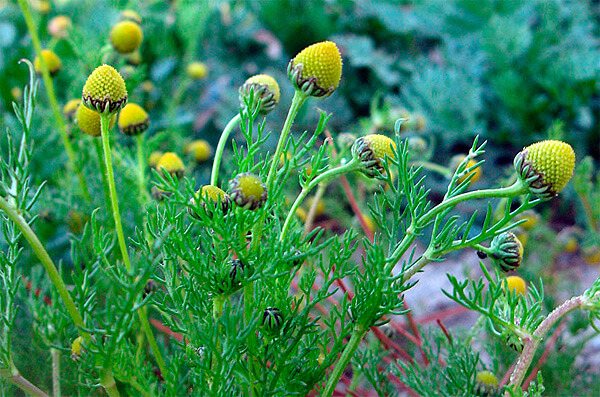

The main task in the summer is to remove the peduncles. This will provoke the bush to bloom again.
The second time they start pruning after the end of flowering. This usually occurs in the second half of July. After flowering, chamomile bushes lose their decorative effect, and therefore there is no special need to preserve them.
The third pruning is carried out during the preparation of plants for wintering. Its main purpose is sanitary and hygienic. Rotting plant residues are a source of the spread of various diseases, as well as a haven for pests. Autumn pruning is carried out before heavy frosts or before the first heavy snowfall.
In this case, the technique for performing pruning depends on the timing of its implementation.
Interesting Facts
- According to the modern dream book, if you dream of large chamomile flowers - soon a joyful event will take place, and weaving a wreath of daisies - fortunately with a loved one.
- Large garden chamomile is a real find for florists: in a bouquet does not fade up to 10 days.
- Chamomile - a symbol of light, purity and fidelity, therefore, it is no coincidence that she was chosen as the subject of fortune-telling; for these purposes, from ancient times, the largest inflorescences were chosen, which approved the plant as the most appreciated by lovers.
- Garden chamomile, like chamomile officinalis, easily relieves inflammation., has an antibacterial and sedative effect, and is also used to prepare teas and decoctions.
Fertilizing and feeding for a bright bloom
When growing garden chamomile, it is impossible to do without fertilization, because it needs food to bloom a huge inflorescence. The larger in growth and more active in flowering the variety, the more nutrients it needs.


Water the chamomile as the soil dries
Phosphorus-potassium fertilizer is applied in the fall when preparing a flower garden for future plantings. In the future, nitrogen fertilizing is carried out:
- in the spring after the complete disappearance of the snow cover;
- at the beginning of budding;
- in the middle of July.
Ammonium nitrate, urea, mullein, or bird droppings diluted in water are suitable nitrogen sources.
Attention! Chicken manure is a fertilizer saturated with nitrogenous substances and capable of burning chamomile roots. Dilute it 1:15 and apply only on wet soil.
Autumn pruning
Falling chamomile pruning is no less important than summer pruning. Its main purpose is to remove the dying aerial part and prepare the bushes for wintering. They start it after the onset of a stable cold snap. For most regions of Russia, this is the second half of October.
With the help of a sharp pruner, the shoots are cut as close to the soil surface as possible. Leave them in place. Moreover, in no case should they be used to hide bushes. All plant residues should be destroyed. They can contain both pathogenic fungi and larvae of various pests.
It is also useful to read: Persian chamomile, its use and cultivation
In general, pruning chamomile is quite simple and does not require complex manipulations. The main thing is to strictly observe the timing of its implementation. And then the plants will surely thank you with good development and abundant flowering.

